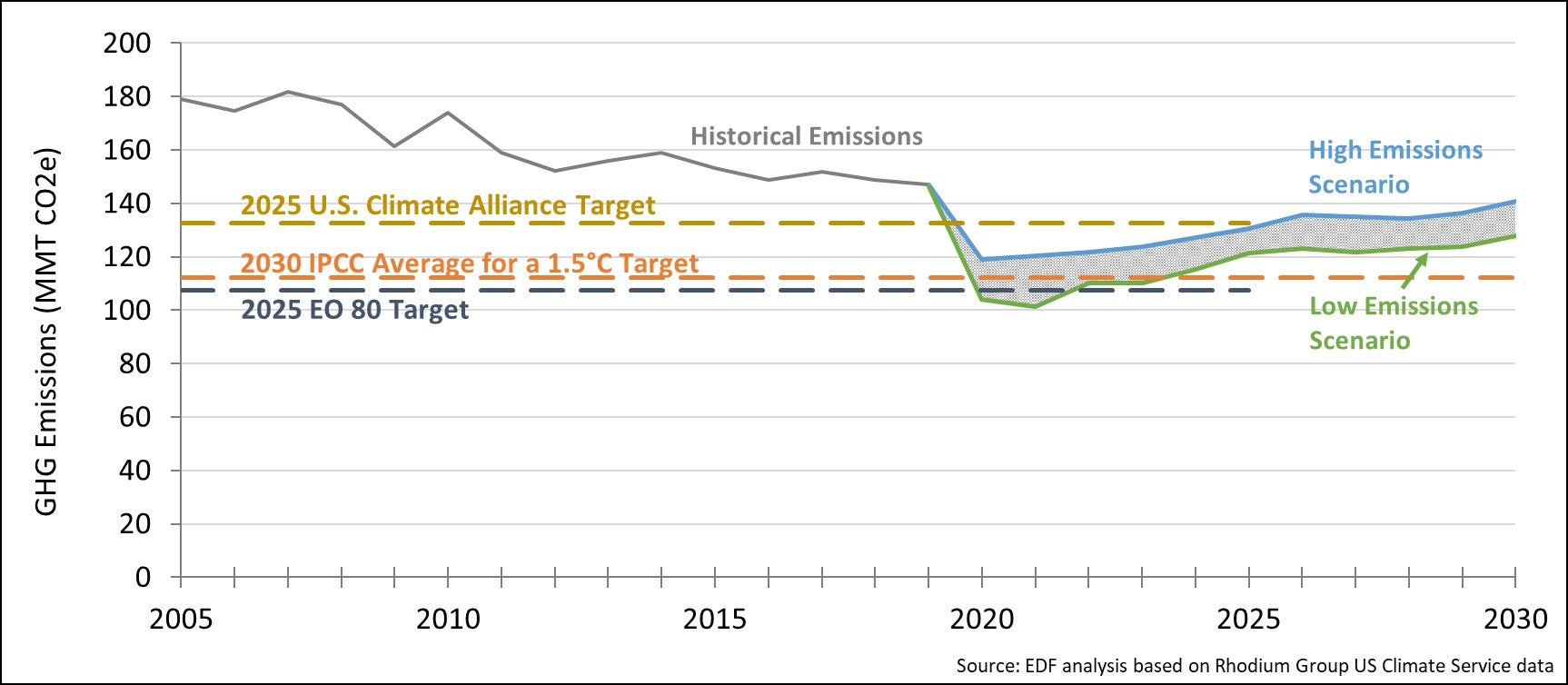As flooding, extreme heat and stronger hurricanes increasingly strain North Carolina’s communities and economy, new analysis from EDF shows that the state’s current policies are not enough to curb the worst climate impacts to come. Despite Governor Cooper’s commitments to slash climate-warming pollution, the analysis finds that the state is off course for bringing emissions down consistent with a key, science-based target for 2030. However, the state can still close its “emission gap” and get on track with a strong policy toolkit that includes placing enforceable limits on greenhouse gas emissions.
North Carolina’s commitment to climate progress
North Carolina was the first southern state to commit to climate action, after the Trump administration announced its withdrawal from the global Paris Agreement over three years ago. Gov Cooper joined the U.S. Climate Alliance, a bipartisan group of governors dedicated to upholding the goals of the Paris Agreement, committing to reduce greenhouse gas emissions 26 to 28% below 2005 levels by 2025. The following year, he established additional climate targets through his Executive Order 80 (“EO 80”) that went even further, calling for statewide reductions in greenhouse gas emissions to 40% below 2005 levels by 2025. In addition to the economy-wide target, EO 80 established a zero-emission vehicle target for 2025 and called on the Department of Environmental Quality to develop a Clean Energy Plan. This plan recommended that the state reduce carbon emissions from the electric power sector by 70% from 2005 levels by 2030 and to net-zero by 2050.
Since making these commitments, the state has yet to adopt concrete policies that can deliver. Policymakers have been locked in a state of analysis paralysis, focused on analysis and planning, particularly in the electric utility sector. Even with renewed optimism for federal climate action under a Biden-Harris administration, the urgency of the climate crisis demands that states meet their commitments on time. North Carolina must deliver on its climate targets immediately, and those reductions must result in a strong, clean economy.
Understanding North Carolina’s emissions gap
To evaluate whether the state is on track to meet its targets, EDF’s analysis looked at projected emissions through 2030 based on existing policies using data from Rhodium Group’s U.S. Climate Service. The analysis also compared projected emissions to trajectories consistent with limiting warming to 1.5°C, consistent with the goals of the Paris Agreement, which U.S. Climate Alliance states have committed to pursue. The analysis considered a range of emission trajectories based on the pace of economic recovery from the COVID-19 pandemic, presenting a high and low emissions scenario that demonstrates an upper and lower bound, even given the high degree of uncertainty in future emissions.
As shown in the figure below, North Carolina achieving emissions levels consistent with the EO 80 target and the IPCC average for a 1.5°C target is within reach. However, the analysis shows that emissions will not remain at those levels in the long-term, as economic activity and energy demand post-pandemic drive emissions back up in the near future. Gov Cooper will need to take enforceable action in order to deliver on the commitments he has made for the state.
Moreover, with 2025 rapidly approaching, the governor should set economy-wide reduction targets looking to 2030 and beyond – and swiftly develop the regulations necessary to put the state on track for achieving them.
North Carolina Economy-Wide GHG Emissions and Targets
Finding the right policy tools
Importantly, the report outlines the tools that every state should have in its policy toolkit to deliver concrete action and close their emissions gaps. Policy tools that focus on emission limits will be essential to achieving the state’s goals, and a declining limit on emissions can guarantee emissions decline at the pace and scale necessary. Combining a declining limit with a price on carbon pollution, as the Regional Greenhouse Gas Initiative (RGGI) does for the electric power sector, can deliver tremendous environmental benefits, such as cleaner air, and accelerate near-term reductions while fostering a strong and growing economy.
In developing climate policy approaches, North Carolina should:
- Evaluate progress based on emissions metrics: Climate policies should be calibrated toward securing reductions that decline immediately, and persistently, over time.
- Establish a declining, enforceable limit on greenhouse gas pollution.
- Ensure environmental and economic benefits are directed to disproportionately-impacted communities, including communities on the frontlines of climate impacts and workers impacted by the transition away from fossil fuels.
- Consider an approach that puts a price on pollution.
- Catalyze the development and deployment of clean technologies.
RGGI offers an opportunity to limit power sector pollution
For North Carolina to get on track with its economy-wide emissions targets, achieving deep and fast reductions in the electric-power sector is imperative. EDF found in a previous analysis that RGGI, a cap and invest program with 10 states in the Northeast and mid-Atlantic, can help North Carolina meet its power sector emissions targets while reducing costs, and can provide a new tool for driving targeted investments in the wake of the COVID-19 pandemic. It offers a flexible framework that, if well-designed, can direct the economic and air quality benefits to communities most overburdened by air pollution. Further, RGGI can help North Carolina achieve critical climate reductions at a low-cost in the near-term, while catalyzing the innovation necessary to spur deep, cost-effective reductions at greater scale in the future.
With a vanishing window for meaningful action on emissions, North Carolina needs to move swiftly from rhetoric to reality on its climate commitments. By passing policies that limit greenhouse gas emissions, lift up the most burdened communities and grow a stronger, clean economy, the state can deliver on its promises before it’s too late.
Read the full EDF analysis here.
Read more about the benefits of the Regional Greenhouse Gas Initiative (RGGI) in this fact sheet.
